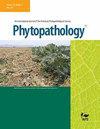Brandon G Roy, Gérard Demangeat, Sophie Meyer, Claude Gertz, Véronique Komar, Isabelle R Martin, Marc F Fuchs
求助PDF
{"title":"一种土壤传播的病毒通过单个氨基酸修饰植物宿主的根系结构并影响线虫的传播。","authors":"Brandon G Roy, Gérard Demangeat, Sophie Meyer, Claude Gertz, Véronique Komar, Isabelle R Martin, Marc F Fuchs","doi":"10.1094/PHYTO-03-25-0105-R","DOIUrl":null,"url":null,"abstract":"<p><p>Grapevine fanleaf virus (GFLV) is the main causative agent of fanleaf degeneration disease. Transmission of GFLV is exclusively accomplished by the ectoparasitic dagger nematode <i>Xiphinema index</i> in a noncirculative, nonpropagative mode. Previous studies of GFLV-host interactions revealed strain- and viral amino acid-specific changes to the root system architecture (RSA) in <i>Nicotiana benthamiana</i>. Here, a two-step assay first revealed the suitability of <i>N. benthamiana</i> in comparison with <i>Vitis</i> spp. for the transmission of GFLV by <i>X. index</i>. Then, a novel one-step assay revealed strain- and viral amino acid-specific differences in transmission between wild-type GFLV strains F13 and GHu and their respective mutants, with a single residue change to position 802 of the putative RNA-dependent RNA polymerase (protein 1E<sup>Pol*/Sd</sup>). Higher transmission rates were obtained with asymptomatic mutant GFLV-GHu 1E<sub>K802G</sub> (33.33%, 16/48) versus symptomatic wild-type GFLV-GHu (25.53%, 12/47) and with asymptomatic wild-type GFLV-F13 (75%, 30/40) versus symptomatic mutant GFLV-F13 1E<sub>G802K</sub> (51.28%, 20/39). These results indicate that <i>X. index</i>-mediated transmission is influenced by the GFLV strain and the identity of the amino acid in position 802 of protein 1E<sup>Pol*/Sd</sup>, with a glycine favoring transmission and a lysine reducing transmission. As expected, GFLV transmission was significantly correlated with differences in RSA traits, such as the number of root tips and total root length, but not with GFLV titer in <i>X. index</i> or in the roots of donor plants. This is the first report of a soilborne virus modifying both the RSA of a plant host and transmission by its dagger nematode via a single viral amino acid. [Formula: see text] Copyright © 2025 The Author(s). This is an open access article distributed under the CC BY-NC-ND 4.0 International license.</p>","PeriodicalId":20410,"journal":{"name":"Phytopathology","volume":" ","pages":"1223-1235"},"PeriodicalIF":3.1000,"publicationDate":"2025-09-01","publicationTypes":"Journal Article","fieldsOfStudy":null,"isOpenAccess":false,"openAccessPdf":"","citationCount":"0","resultStr":"{\"title\":\"A Soilborne Virus Modifies the Root System Architecture of a Plant Host via a Single Amino Acid and Influences Nematode Transmission.\",\"authors\":\"Brandon G Roy, Gérard Demangeat, Sophie Meyer, Claude Gertz, Véronique Komar, Isabelle R Martin, Marc F Fuchs\",\"doi\":\"10.1094/PHYTO-03-25-0105-R\",\"DOIUrl\":null,\"url\":null,\"abstract\":\"<p><p>Grapevine fanleaf virus (GFLV) is the main causative agent of fanleaf degeneration disease. Transmission of GFLV is exclusively accomplished by the ectoparasitic dagger nematode <i>Xiphinema index</i> in a noncirculative, nonpropagative mode. Previous studies of GFLV-host interactions revealed strain- and viral amino acid-specific changes to the root system architecture (RSA) in <i>Nicotiana benthamiana</i>. Here, a two-step assay first revealed the suitability of <i>N. benthamiana</i> in comparison with <i>Vitis</i> spp. for the transmission of GFLV by <i>X. index</i>. Then, a novel one-step assay revealed strain- and viral amino acid-specific differences in transmission between wild-type GFLV strains F13 and GHu and their respective mutants, with a single residue change to position 802 of the putative RNA-dependent RNA polymerase (protein 1E<sup>Pol*/Sd</sup>). Higher transmission rates were obtained with asymptomatic mutant GFLV-GHu 1E<sub>K802G</sub> (33.33%, 16/48) versus symptomatic wild-type GFLV-GHu (25.53%, 12/47) and with asymptomatic wild-type GFLV-F13 (75%, 30/40) versus symptomatic mutant GFLV-F13 1E<sub>G802K</sub> (51.28%, 20/39). These results indicate that <i>X. index</i>-mediated transmission is influenced by the GFLV strain and the identity of the amino acid in position 802 of protein 1E<sup>Pol*/Sd</sup>, with a glycine favoring transmission and a lysine reducing transmission. As expected, GFLV transmission was significantly correlated with differences in RSA traits, such as the number of root tips and total root length, but not with GFLV titer in <i>X. index</i> or in the roots of donor plants. This is the first report of a soilborne virus modifying both the RSA of a plant host and transmission by its dagger nematode via a single viral amino acid. [Formula: see text] Copyright © 2025 The Author(s). This is an open access article distributed under the CC BY-NC-ND 4.0 International license.</p>\",\"PeriodicalId\":20410,\"journal\":{\"name\":\"Phytopathology\",\"volume\":\" \",\"pages\":\"1223-1235\"},\"PeriodicalIF\":3.1000,\"publicationDate\":\"2025-09-01\",\"publicationTypes\":\"Journal Article\",\"fieldsOfStudy\":null,\"isOpenAccess\":false,\"openAccessPdf\":\"\",\"citationCount\":\"0\",\"resultStr\":null,\"platform\":\"Semanticscholar\",\"paperid\":null,\"PeriodicalName\":\"Phytopathology\",\"FirstCategoryId\":\"97\",\"ListUrlMain\":\"https://doi.org/10.1094/PHYTO-03-25-0105-R\",\"RegionNum\":2,\"RegionCategory\":\"农林科学\",\"ArticlePicture\":[],\"TitleCN\":null,\"AbstractTextCN\":null,\"PMCID\":null,\"EPubDate\":\"2025/9/2 0:00:00\",\"PubModel\":\"Epub\",\"JCR\":\"Q2\",\"JCRName\":\"PLANT SCIENCES\",\"Score\":null,\"Total\":0}","platform":"Semanticscholar","paperid":null,"PeriodicalName":"Phytopathology","FirstCategoryId":"97","ListUrlMain":"https://doi.org/10.1094/PHYTO-03-25-0105-R","RegionNum":2,"RegionCategory":"农林科学","ArticlePicture":[],"TitleCN":null,"AbstractTextCN":null,"PMCID":null,"EPubDate":"2025/9/2 0:00:00","PubModel":"Epub","JCR":"Q2","JCRName":"PLANT SCIENCES","Score":null,"Total":0}
引用次数: 0
引用
批量引用

 求助内容:
求助内容: 应助结果提醒方式:
应助结果提醒方式:


